Leadership Analysis: The Contingency Approach Explained in Detail
VerifiedAdded on 2021/06/17
|7
|1041
|50
Essay
AI Summary
This essay provides an in-depth analysis of the contingency approach to leadership, a management theory that emphasizes adaptability and flexibility in response to various situations. It highlights the advantages of this approach, including flexible management styles, employee empowerment, and flexible task structures. The essay also critically examines the disadvantages, such as its reactive nature, insufficient literature for practical application, and inherent complexity. The discussion references key academic sources, such as Fiedler (2006), Alexander (2017), Hatch (2018), Miner (2015), and Certo (2018), to support its arguments and provide a comprehensive overview of the topic. The essay concludes by summarizing the key takeaways and implications of the contingency approach for effective leadership and management in dynamic business environments.
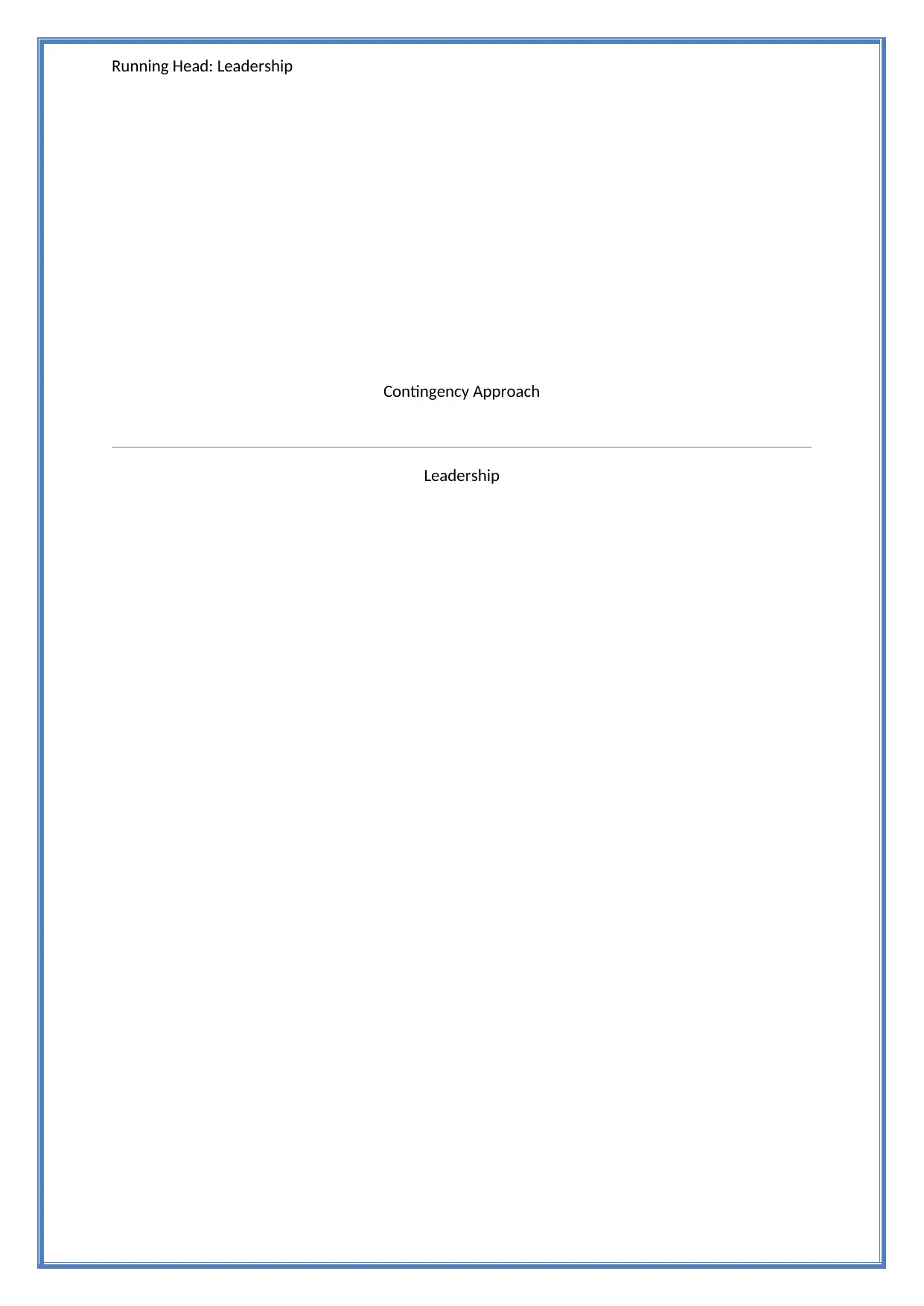
Running Head: Leadership
Contingency Approach
Leadership
Contingency Approach
Leadership
Paraphrase This Document
Need a fresh take? Get an instant paraphrase of this document with our AI Paraphraser
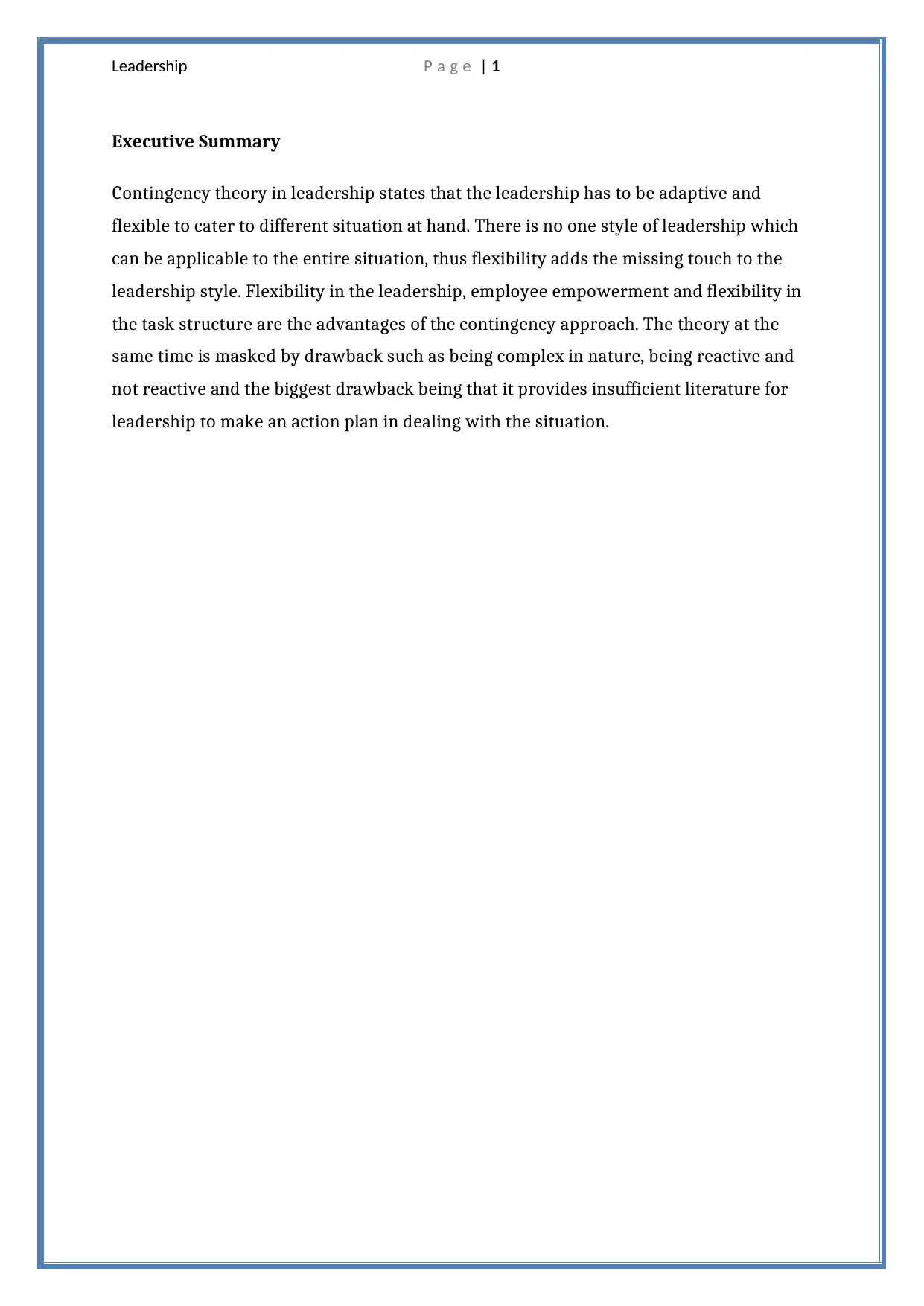
Leadership P a g e | 1
Executive Summary
Contingency theory in leadership states that the leadership has to be adaptive and
flexible to cater to different situation at hand. There is no one style of leadership which
can be applicable to the entire situation, thus flexibility adds the missing touch to the
leadership style. Flexibility in the leadership, employee empowerment and flexibility in
the task structure are the advantages of the contingency approach. The theory at the
same time is masked by drawback such as being complex in nature, being reactive and
not reactive and the biggest drawback being that it provides insufficient literature for
leadership to make an action plan in dealing with the situation.
Executive Summary
Contingency theory in leadership states that the leadership has to be adaptive and
flexible to cater to different situation at hand. There is no one style of leadership which
can be applicable to the entire situation, thus flexibility adds the missing touch to the
leadership style. Flexibility in the leadership, employee empowerment and flexibility in
the task structure are the advantages of the contingency approach. The theory at the
same time is masked by drawback such as being complex in nature, being reactive and
not reactive and the biggest drawback being that it provides insufficient literature for
leadership to make an action plan in dealing with the situation.
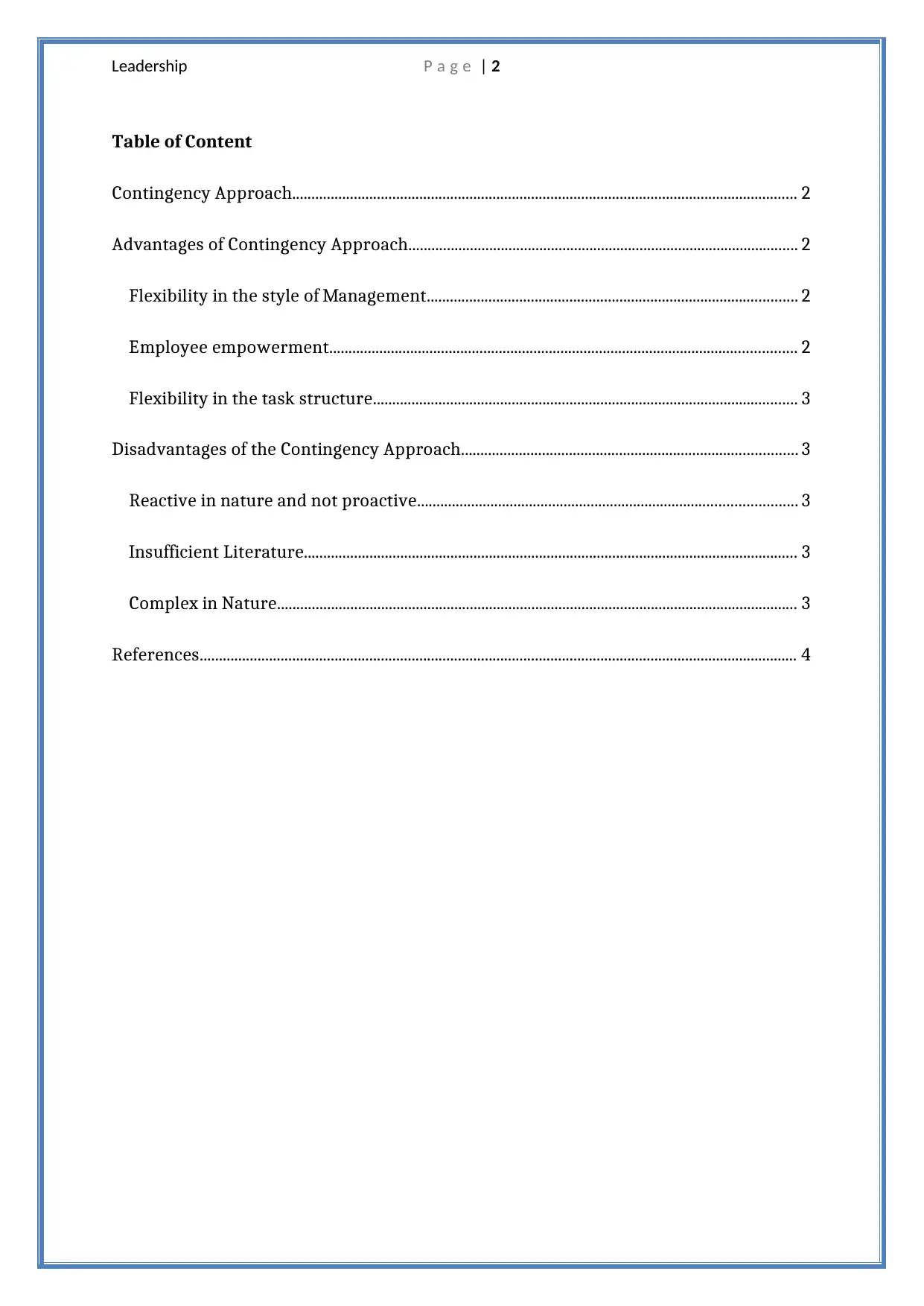
Leadership P a g e | 2
Table of Content
Contingency Approach................................................................................................................................... 2
Advantages of Contingency Approach..................................................................................................... 2
Flexibility in the style of Management................................................................................................ 2
Employee empowerment......................................................................................................................... 2
Flexibility in the task structure.............................................................................................................. 3
Disadvantages of the Contingency Approach....................................................................................... 3
Reactive in nature and not proactive.................................................................................................. 3
Insufficient Literature................................................................................................................................ 3
Complex in Nature....................................................................................................................................... 3
References........................................................................................................................................................... 4
Table of Content
Contingency Approach................................................................................................................................... 2
Advantages of Contingency Approach..................................................................................................... 2
Flexibility in the style of Management................................................................................................ 2
Employee empowerment......................................................................................................................... 2
Flexibility in the task structure.............................................................................................................. 3
Disadvantages of the Contingency Approach....................................................................................... 3
Reactive in nature and not proactive.................................................................................................. 3
Insufficient Literature................................................................................................................................ 3
Complex in Nature....................................................................................................................................... 3
References........................................................................................................................................................... 4
⊘ This is a preview!⊘
Do you want full access?
Subscribe today to unlock all pages.

Trusted by 1+ million students worldwide

Leadership P a g e | 3
Contingency Approach
Contingency approach is a management theory which implies that the best and the most
appropriate style of management is dependent on the context of the situation and
adopting one single and rigid style will prove harmful for the business and the
leadership. It is most definitely most relevant approach in the present business context
which is highly dynamic and ever evolving in nature. The implication for the
management lies in assessing the situation at hand and finding the best possible person
or the resource to handle the situation or challenge at hand. It also implies assigning or
task delegation on the basis of skill or competency required to complete the job
irrespective of the position in the organization (Fiedler, 2006).
Advantages of Contingency Approach
Flexibility in the style of Management
Before the Fiedler’s contingency theory expert and psychologists studying leadership
assumed that the leadership follows a special trait under which all the leaders fall. But
the theory opened the eyes of everyone and was established as a ground breaking
theory. According to the theory leadership style varies according to the organization, its
business structure, stress level, type of work and many more. Thus, it can be said that
there is no one model of leadership which can lay the ground rule of success. A leader
has to be adaptive and flexible to make the most out of the situation irrespective of
his/her leadership style (Alexander, 2017).
Employee empowerment
Under the Contingency approach, opinion of the employee matter the most, and success
of leadership can be seen as directly proportional to the relationship with the
employees. Leadership has the responsibility to inflict upon the employees the values of
the organization and the virtues of leadership for enhanced co-operation. In the process,
leadership acknowledges and comprehends the feedback of the employees and takes it
into consideration while decision making. Thus, employee empowerment is one of the
most important advantages of contingency approach in leadership (Hatch, 2018).
Contingency Approach
Contingency approach is a management theory which implies that the best and the most
appropriate style of management is dependent on the context of the situation and
adopting one single and rigid style will prove harmful for the business and the
leadership. It is most definitely most relevant approach in the present business context
which is highly dynamic and ever evolving in nature. The implication for the
management lies in assessing the situation at hand and finding the best possible person
or the resource to handle the situation or challenge at hand. It also implies assigning or
task delegation on the basis of skill or competency required to complete the job
irrespective of the position in the organization (Fiedler, 2006).
Advantages of Contingency Approach
Flexibility in the style of Management
Before the Fiedler’s contingency theory expert and psychologists studying leadership
assumed that the leadership follows a special trait under which all the leaders fall. But
the theory opened the eyes of everyone and was established as a ground breaking
theory. According to the theory leadership style varies according to the organization, its
business structure, stress level, type of work and many more. Thus, it can be said that
there is no one model of leadership which can lay the ground rule of success. A leader
has to be adaptive and flexible to make the most out of the situation irrespective of
his/her leadership style (Alexander, 2017).
Employee empowerment
Under the Contingency approach, opinion of the employee matter the most, and success
of leadership can be seen as directly proportional to the relationship with the
employees. Leadership has the responsibility to inflict upon the employees the values of
the organization and the virtues of leadership for enhanced co-operation. In the process,
leadership acknowledges and comprehends the feedback of the employees and takes it
into consideration while decision making. Thus, employee empowerment is one of the
most important advantages of contingency approach in leadership (Hatch, 2018).
Paraphrase This Document
Need a fresh take? Get an instant paraphrase of this document with our AI Paraphraser
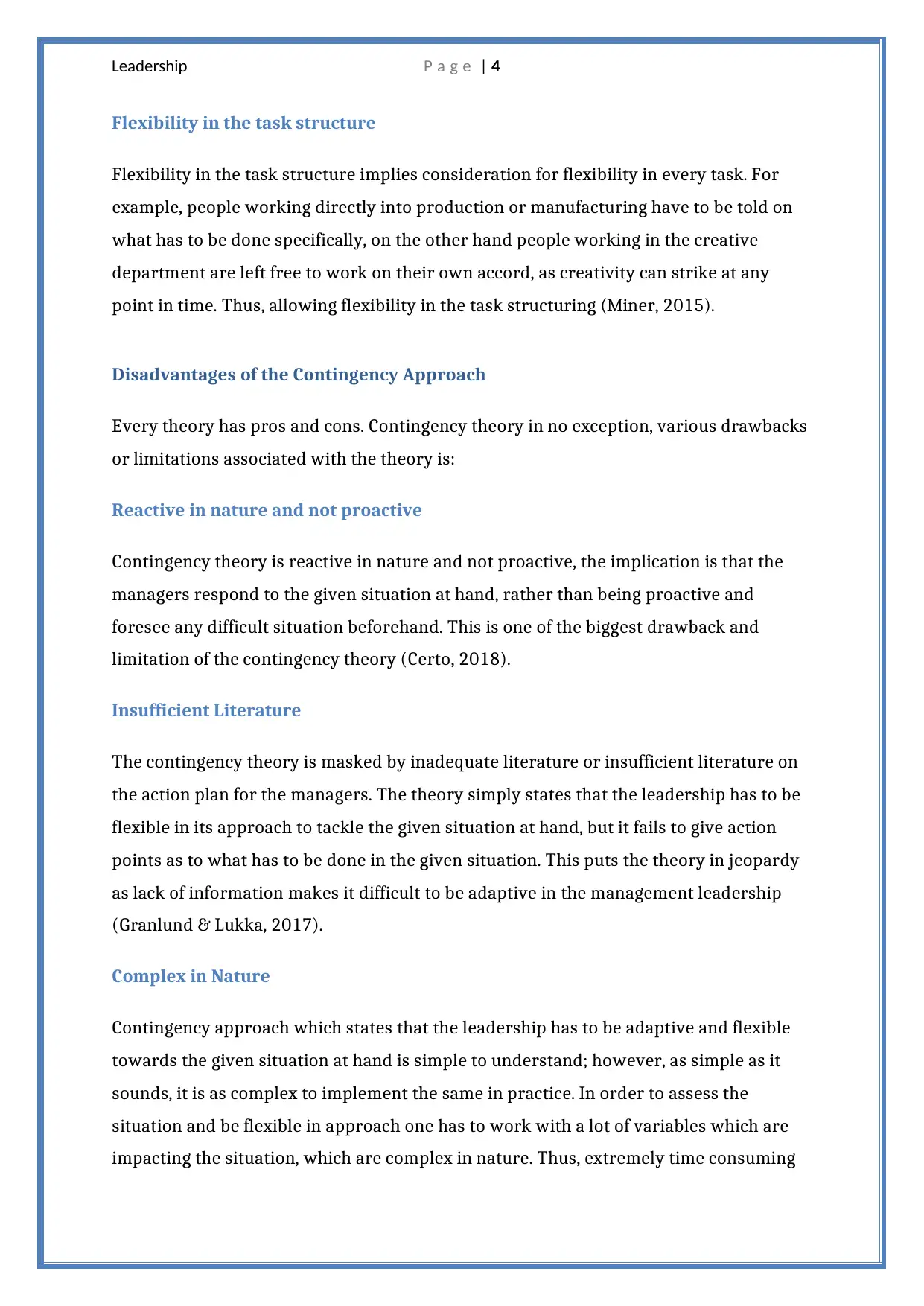
Leadership P a g e | 4
Flexibility in the task structure
Flexibility in the task structure implies consideration for flexibility in every task. For
example, people working directly into production or manufacturing have to be told on
what has to be done specifically, on the other hand people working in the creative
department are left free to work on their own accord, as creativity can strike at any
point in time. Thus, allowing flexibility in the task structuring (Miner, 2015).
Disadvantages of the Contingency Approach
Every theory has pros and cons. Contingency theory in no exception, various drawbacks
or limitations associated with the theory is:
Reactive in nature and not proactive
Contingency theory is reactive in nature and not proactive, the implication is that the
managers respond to the given situation at hand, rather than being proactive and
foresee any difficult situation beforehand. This is one of the biggest drawback and
limitation of the contingency theory (Certo, 2018).
Insufficient Literature
The contingency theory is masked by inadequate literature or insufficient literature on
the action plan for the managers. The theory simply states that the leadership has to be
flexible in its approach to tackle the given situation at hand, but it fails to give action
points as to what has to be done in the given situation. This puts the theory in jeopardy
as lack of information makes it difficult to be adaptive in the management leadership
(Granlund & Lukka, 2017).
Complex in Nature
Contingency approach which states that the leadership has to be adaptive and flexible
towards the given situation at hand is simple to understand; however, as simple as it
sounds, it is as complex to implement the same in practice. In order to assess the
situation and be flexible in approach one has to work with a lot of variables which are
impacting the situation, which are complex in nature. Thus, extremely time consuming
Flexibility in the task structure
Flexibility in the task structure implies consideration for flexibility in every task. For
example, people working directly into production or manufacturing have to be told on
what has to be done specifically, on the other hand people working in the creative
department are left free to work on their own accord, as creativity can strike at any
point in time. Thus, allowing flexibility in the task structuring (Miner, 2015).
Disadvantages of the Contingency Approach
Every theory has pros and cons. Contingency theory in no exception, various drawbacks
or limitations associated with the theory is:
Reactive in nature and not proactive
Contingency theory is reactive in nature and not proactive, the implication is that the
managers respond to the given situation at hand, rather than being proactive and
foresee any difficult situation beforehand. This is one of the biggest drawback and
limitation of the contingency theory (Certo, 2018).
Insufficient Literature
The contingency theory is masked by inadequate literature or insufficient literature on
the action plan for the managers. The theory simply states that the leadership has to be
flexible in its approach to tackle the given situation at hand, but it fails to give action
points as to what has to be done in the given situation. This puts the theory in jeopardy
as lack of information makes it difficult to be adaptive in the management leadership
(Granlund & Lukka, 2017).
Complex in Nature
Contingency approach which states that the leadership has to be adaptive and flexible
towards the given situation at hand is simple to understand; however, as simple as it
sounds, it is as complex to implement the same in practice. In order to assess the
situation and be flexible in approach one has to work with a lot of variables which are
impacting the situation, which are complex in nature. Thus, extremely time consuming
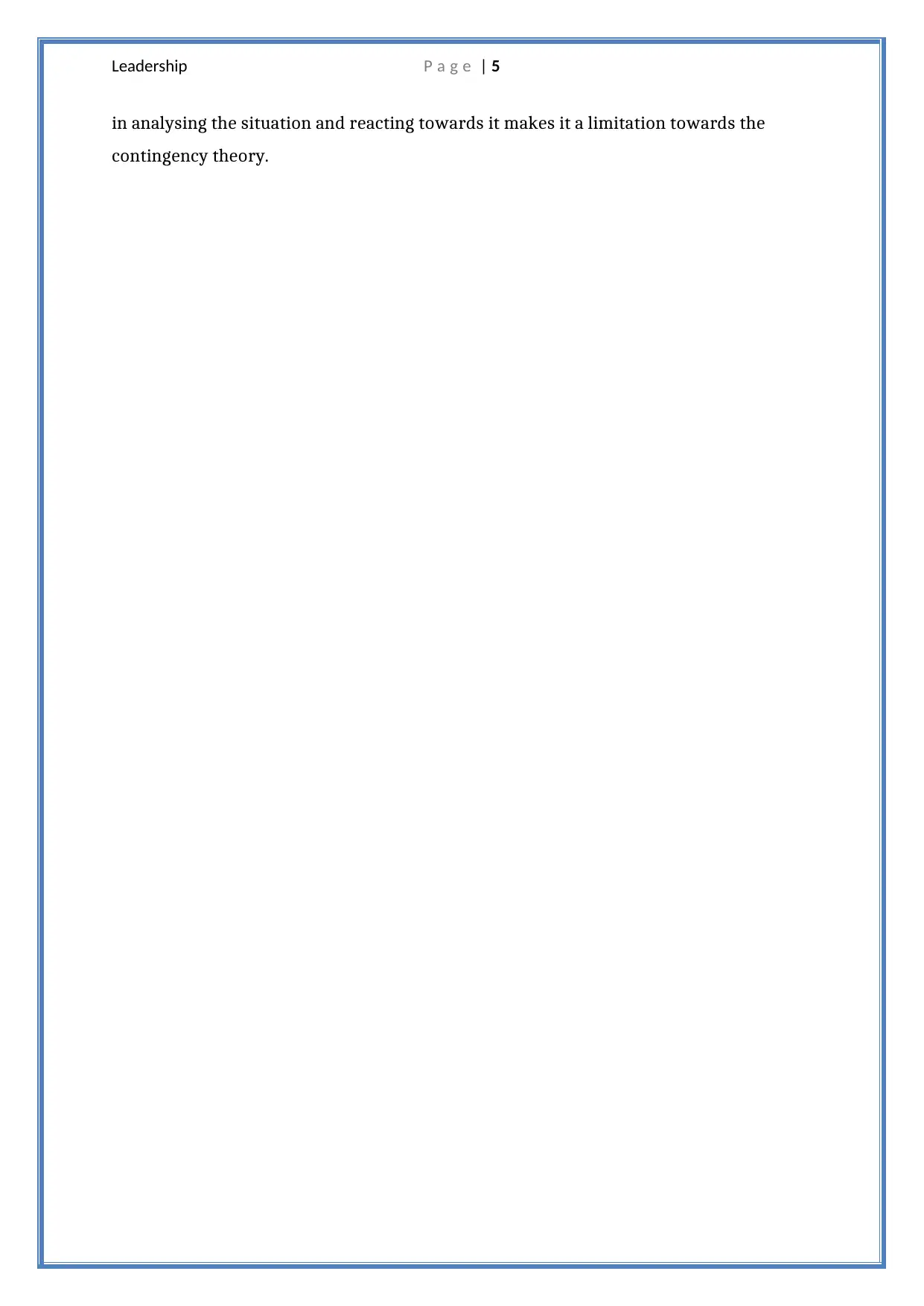
Leadership P a g e | 5
in analysing the situation and reacting towards it makes it a limitation towards the
contingency theory.
in analysing the situation and reacting towards it makes it a limitation towards the
contingency theory.
⊘ This is a preview!⊘
Do you want full access?
Subscribe today to unlock all pages.

Trusted by 1+ million students worldwide

Leadership P a g e | 6
References
Alexander, E., 2017. After rationality: Towards a contingency theory for planning.
In Explorations in planning theory (pp. 45-64). Routledge.
Certo, S.C., 2018. Supervision: Concepts and skill-building. McGraw-Hill Education.
Fiedler, F.E., 2006. The Contingency model: H Theory of Leadership Effectiveness. Small
Groups: Key Readings, p.369.
Granlund, M. and Lukka, K., 2017. Investigating highly established research paradigms:
Reviving contextuality in contingency theory based management accounting
research. Critical Perspectives on Accounting, 45, pp.63-80.
Hatch, M.J., 2018. Organization theory: Modern, symbolic, and postmodern perspectives.
Oxford university press.
Miner, J.B., 2015. Organizational behavior 1: Essential theories of motivation and
leadership. Routledge.
References
Alexander, E., 2017. After rationality: Towards a contingency theory for planning.
In Explorations in planning theory (pp. 45-64). Routledge.
Certo, S.C., 2018. Supervision: Concepts and skill-building. McGraw-Hill Education.
Fiedler, F.E., 2006. The Contingency model: H Theory of Leadership Effectiveness. Small
Groups: Key Readings, p.369.
Granlund, M. and Lukka, K., 2017. Investigating highly established research paradigms:
Reviving contextuality in contingency theory based management accounting
research. Critical Perspectives on Accounting, 45, pp.63-80.
Hatch, M.J., 2018. Organization theory: Modern, symbolic, and postmodern perspectives.
Oxford university press.
Miner, J.B., 2015. Organizational behavior 1: Essential theories of motivation and
leadership. Routledge.
1 out of 7
Related Documents
Your All-in-One AI-Powered Toolkit for Academic Success.
+13062052269
info@desklib.com
Available 24*7 on WhatsApp / Email
![[object Object]](/_next/static/media/star-bottom.7253800d.svg)
Unlock your academic potential
Copyright © 2020–2026 A2Z Services. All Rights Reserved. Developed and managed by ZUCOL.





